Location: Lat: 72 54.247 Long: 153 58.630 Sunrise: 9:36 am Sunset: 6:39 pm
Jump to Sounds of the Arctic #5
Feeling a bit antsy after a few days of transit without much to do, I decided to join the Ice team from University of Alaska at Fairbanks again. They were working on a flow of ice on the port side of the boat.
The first thing after getting on the ice that had to happen was cutting a hole into the ice. Shawn scoped out the area and then decided where the best place to dive would be. He then used a large ice saw to cut the triangle shaped hole in the ice.
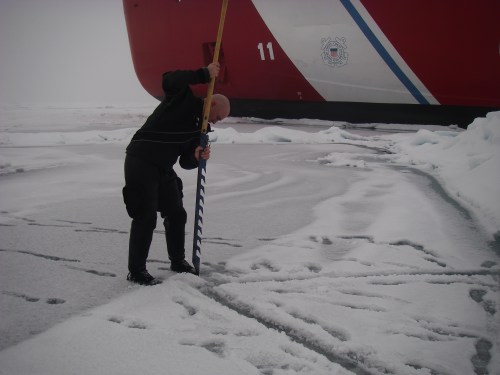
The divers then proceeded to safely complete their four dives in the icy cold water. While under the water, the divers are document their exploration with video and photography. They have very high tech cameras and video cameras that are equipped with lights to capture their work.
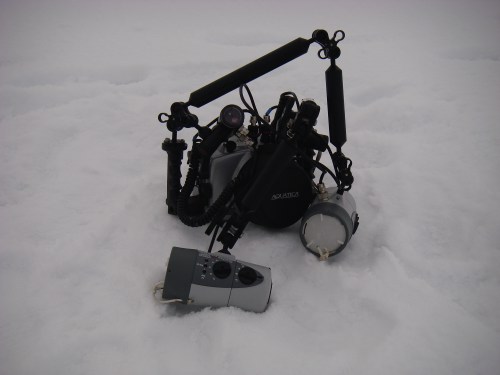
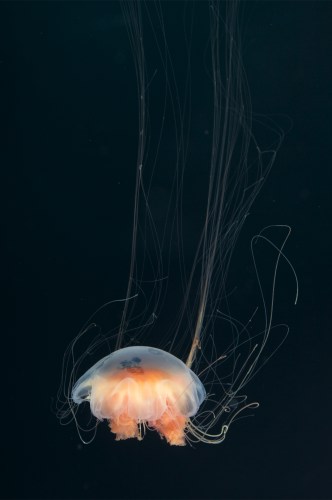
I worked more closely with the ice coring team today to lend an extra hand. First, the team used an auger (a big drill) to cut a large hole in the ice in order to collect water samples and run an experiment.
In this picture, you can see Brenna lowering the CTDA research tool that is submerged in the water to measure conductivity (salinity), temperature, and depth. device to collect water samples for the experiment. They fill two bottles with water and two bottles with water and ice. They then take all of bottles and lower to them to two different depths. They do this to measure the primary production of the algae in the ice and phytoplankton in the water. Algae and phytoplankton are both producers, which are organisms that use sunlight to make their food (photosynthesis). The way they measure how productive these organisms are is by adding isotopes to the bottles and then measuring how much of the isotope the organisms take in. The more they take in, the more they are productive.
A VERY basic explanation of an isotope is a molecule of an element that has a slightly different weight than most of the molecules of the same element. Here is an example: carbon usually has 6 protons and 6 neutrons - meaning it's mass would be 12. However, sometimes carbon has 6 protons and 8 neutrons making the mass 14 instead. Isotopes are useful in science because they can be used to for all different types of data collection.
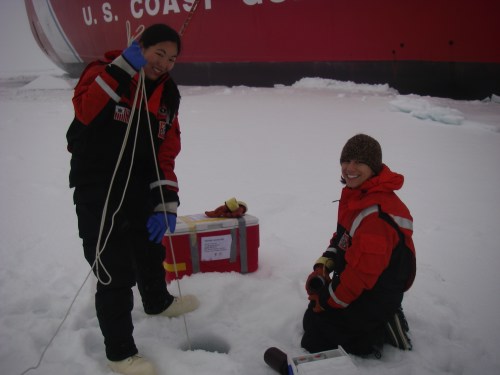
After they get their experiment started, they begin work at collecting several ice core samples. For the first sample, they drill small holes every ten centimeters and take the temperature of the ice core.
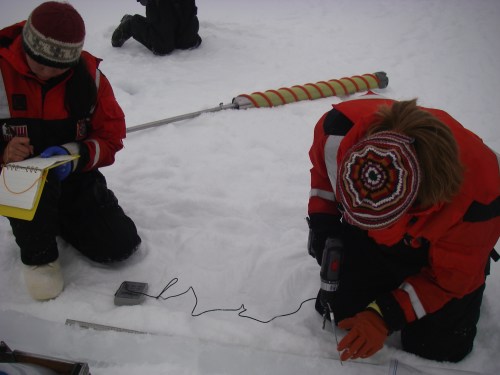
After doing this to the first sample, they collect 5 more ice cores. However this time, they do not have to take the temperature data. Since the ice cores are all taken from the same location, they can assume the temperature is the same for all the samples. They are most interested in the bottom parts of the ice core since this is where living organisms might be. The types of organisms that would living right under the ice are very small arthropods (like very small shrimp). In the bottom part of the ice, they might be able to find copepods and very small worms. In fact, all they keep of the core is the bottom 30 centimeters to analyze for nutrients and bottom 10 centimeters to filter for organisms. The team was surprised today by how thick the ice was that we were on; it was some of the thickest they had seen so far this trip - about 2 meters.
After all the data collection was finished, we could not get back on the boat right away. We had to wait until the helicopter took off - for safety reasons the helicopter and the crane to bring us back on the boat can not operate at the same time. So to keep warm - we got creative! We used extra ice cores to set up goal post and had a quick game of football. Just a few downs and we were toasty and warm!
Once back on the boat, the less glamorous side of science starts. The team works together to clean off all the gear. This is important because remember all of the water is salt water, which corrodes materials pretty easily. The team has a hose with hot fresh water to clean off all their gear before storing it away for the next dive.
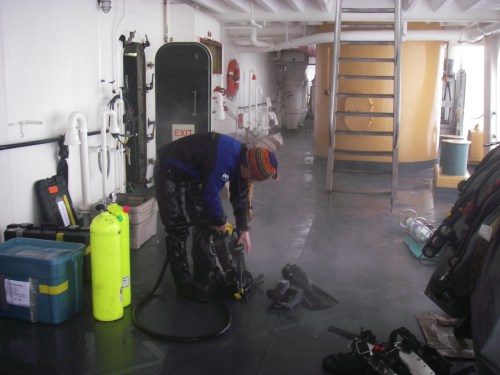
Sound of the Arctic During the second half the day, I was able to find another Sounds of the Arctic for you! Listen to the following sound clip and take a guess as to what you think it might be. If you think you know, feel free to post your guess in the "Ask the Team" section of the site. Check back in tomorrow to find out the answer! Here's a hint - the sound you hear is NOT just static - it's an actual sound. Good luck!


Comments